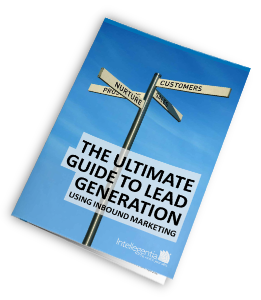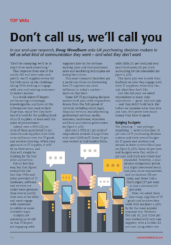
Is "Inbound Sales" just another alternative to Sandler, Holden, Miller-Heiman, SPIN, Value Selling, the Challenger Sale and other sales methodologies? Or is it a new way of thinking?
Or both?
All the aforementioned sales methodologies teach us valuable lessons. They teach how to seek out the "fox" (Holden), to "go for the no" (Sandler) and other techniques for qualifying out time wasters, getting control over the deal and progressing the sale faster than your competitors.
But whilst their aims and methods are sound, it's getting harder and harder to put into practice.
Why?
Because in today's internet-based world buyers appear to have more control.
Indeed, there's been a lot made from stats coming 'across the pond' on how buyers are 59% of the way through their buying process before engaging a sales person. And if you take a deep dive into how your customers originally engaged with your organisation (assuming you have the systems to analyse it ) you'll find a lot of research goes on before they were ready to speak to a sales person, so it is difficult to argue against this stat. Just think about how you buy as a consumer ... research, compare, review, price comparison, references, and finally purchase.
So:
- traditional interruptive lead generation processes such as cold calling and email blasts simply don't work any more. Buyers want to be self-serving: a "Don't call us, we'll call you" mentality exists.
- because much of this research continues right up to the point where they are ready to make a decision and NEED to speak to sales, many sales people are put in a position where they feel they are no longer in control of the sales process.
Before we look at HOW Inside Sales can help sales people gain control, let's look at evidence from a recent UK survey as to WHY this new approach is needed.
Why should we turn to Inbound Sales?
A recent survey by ChannelWeb (www.channelweb.co.uk - Top Var's 2016) has provided us with a tremendous insight into UK IT buyers and the challenge companies face when trying to sell to them. It's a cracking article and I would encourage sales and marketing professionals to read "Don't call us, we'll call you" it in its entirety.
The article, authored by Doug Woodburn, dives into the results of a comprehensive survey into how IT buyers perceive and buy from IT suppliers. Interestingly, the survey goes beyond this to uncover other elements that form their "sphere of influence". This is sobering reading if your sales and marketing processes are more 'traditional' <- polite way of saying it!
One of the key questions in the survey was "How likely are the following methods to convince you to consider engaging with an IT supplier for the first time?"
- Cold Calling or Email comes out dismally - 61% say they are not likely at all to respond to a cold call or email, only 3% rate this method as very likely.
- Blogs and helpful engagement via social media is a more positive channel with between 25-30% of buyers rating the chance of responding as being "very likely".
- Helpful engagement via industry/social forums topped the list with 48% saying this is a "very likely way" of getting engagement from them.
In answer to "Which of these options best describes how you view the role IT suppliers play in your purchasing decision process?"
- 47% stated they have moderate influence: we generally know what we want but sometimes a supplier offers guidance that helps our decision process.
- 24% stated that most of our decisions are an equal mix between our market research and advice from our suppliers
- 22% stated that they (IT suppliers) have little or no influence: we have decided what we want by the time we approach them.
- 6% stated it was impossible to generalise
- 1% stated they lean heavily on suppliers as they are the experts.
The results from this survey gives us more granularity and insight into the IT buying process here in the UK - far more so than the blanket 59% from the US stats we've seen.
One final insight from the survey, which we believe is the crux of why sales processes need to change to meet the needs of today's buyer...
From the comments within the survey, it's clear that what buyers value more than anything is sales people who have researched and understand their businesses, and are helpful, honest and capable of providing solutions to problems.
In summary, if:
- your marketing teams make helpful relevant information available to IT buyers during their research phase in a way that gains engagement, AND
- your sales people use the insight provided by marketing plus target account research to be seen more as helpful, well researched consultants (the basis of Inbound Sales)
...then there's a much better chance of engaging with IT buyers and closing business than if you use those traditional tactics.
So what is Inbound Sales?
Just consider this for one moment ... If the salesperson cannot add value beyond the information the buyer can find on their own through self-service, the buyer has no reason to engage with the salesperson.
The good old days when sales people had all the information and therefore all the power in the buying process have long gone. The basic legacy process of prospecting using cold calls, email blasts, direct mail - pitching using generic company powerpoints - demos talking about features and functions not aligned to buyers needs - and finally, closing - based on your timescales (quarter end etc), not when your buyer is ready - doesn't work any more.
There are two building blocks for an Inbound Sales Strategy:
- Inbound sales teams base their entire sales strategy on the buyer and their journey rather than the seller process.
Inbound sales teams build a sales process that supports the buyer through that journey. As a result, the salesperson and the buyer feel like they are aligned, rather than at odds with one another.
- Inbound salespeople personalise the entire sales experience to the buyer’s context.
With Inbound Sales the conversation and content is personalised to the buyer’s context. Inbound Sales teams listen to buyers pain points and provide insight into how they can help to solve their problems.
Inbound Sales need to be tightly aligned with Inbound Marketing. Focusing on your 'good fit' prospects, their needs and how they respond to you is the key to creating a sustainable and cost effective way of generating more leads and closing deals.
And guess what? If you're the person reviewing their pain points, providing timely insight into solutions and helping the buyer along their journey, then YOU will gain some of that control back.
Inbound Sales is not about waiting for the buyer. It's about assisting the buyer on their terms, in ways that give you a lead over your competitors.
Armed with this insight, do you believe your sales and marketing teams are ready to help today's buyers? It's clear that a change has happened, and if your organisation is not embracing the buyer and their journey, your competitors probably are.
Want to learn more about Inbound Sales? Take a look at our fundamentals workshop.

Download our guide to Inbound Marketing, click on the ebook below.

Or talk to us! Challenge us to help you improve your pipeline, win rates and overall success.
.png?width=250&height=76&name=Intellegentia%20Logo%20(MAIN).png)
